Orion Marine Group’s replacement of a pair of 1960s-era bascule bridges with high-level bridges to greatly improve the main connection between Cape Canaveral and the Florida mainland is proving especially timely as the current space age accelerates to a much more frequent schedule of rocket launches—along with a commensurate uptick in heavy haul load deliveries heading to Kennedy Space Center (KSC).
While the number of rocket launches by NASA, SpaceX and Blue Origin have been steadily increasing in recent years, 2024’s pace appears to be reaching a higher frequency. For example, after facilitating a record 72 rocket launches during 2023, KSC saw 31 launches during the first quarter of 2024 alone, the majority of those by SpaceX. The company—which constructs its rockets in California and ships them cross-country by heavy haul truck to the Cape—is reportedly aiming for as many as 125 total launches in 2024.
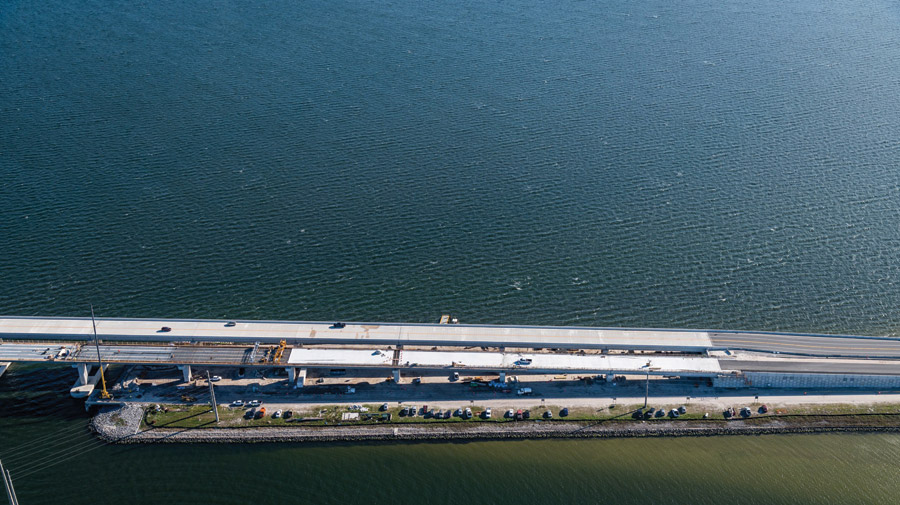
With the eastbound span finished, the team is focused on delivering the westbound span.
Photo by Aerial Innovations, courtesy WSP
Against that backdrop of skyrocketing launch numbers, Tampa-based Orion’s ahead-of-schedule completion of the first of two 4,025-ft-long high-level concrete bridges featuring 26 spans each was ballyhooed by local, state and NASA officials last June at a ceremony at the bridge site.
Speaking at that celebration, Florida Dept. of Transportation (FDOT) Secretary Jared Perdue noted the project’s importance, stating, “These bridges not only improve the transportation for spacecraft and payloads, but also increase safety and connectivity for motorists driving on top of it and marine traffic using the waterway below it.”
“These bridges not only improve transporta-tion for spacecraft and payloads, but also increase safety and connectivity for motorists.”
—Jared Perdue, Secretary, FDOT
In actuality, though, Orion’s fortunate 125-day early completion of the 53-ft, 8-in.-wide eastbound span was right on track with the contractor’s original planned schedule to achieve the full $3-million incentive payment for that portion of the project, which kicked off in December 2021. Another $2-million incentive payment awaits timely completion of the westbound bridge, which is 11 ft narrower than its sister structure to the south.
Engineer Volkert Inc. designed the nearly twin spans to achieve the 75-year service life mandated by FDOT. In a statement provided to ENR, Alex Caso, Volkert’s structural engineer of record, said, “The NASA bridge presented us with unique design challenges due to the space freight transport vehicles and vessel impact requirements. The latter was accounted for in design by modeling distribution of the impact loads across the foundations of both the eastbound and westbound bridges.”
The eastbound structure was designed to be wider primarily to better facilitate the transport of heavy loads, but its extra 11 ft in width also was enough to temporarily accommodate two lanes each of eastbound and westbound traffic—critical to the more than 12,000 workers regularly commuting to KSC.
That extra width has also helped the team with its management of maintenance of traffic responsibilities, says Jim Lynch, project manager with WSP, the project’s construction engineering and inspection (CEI) firm.
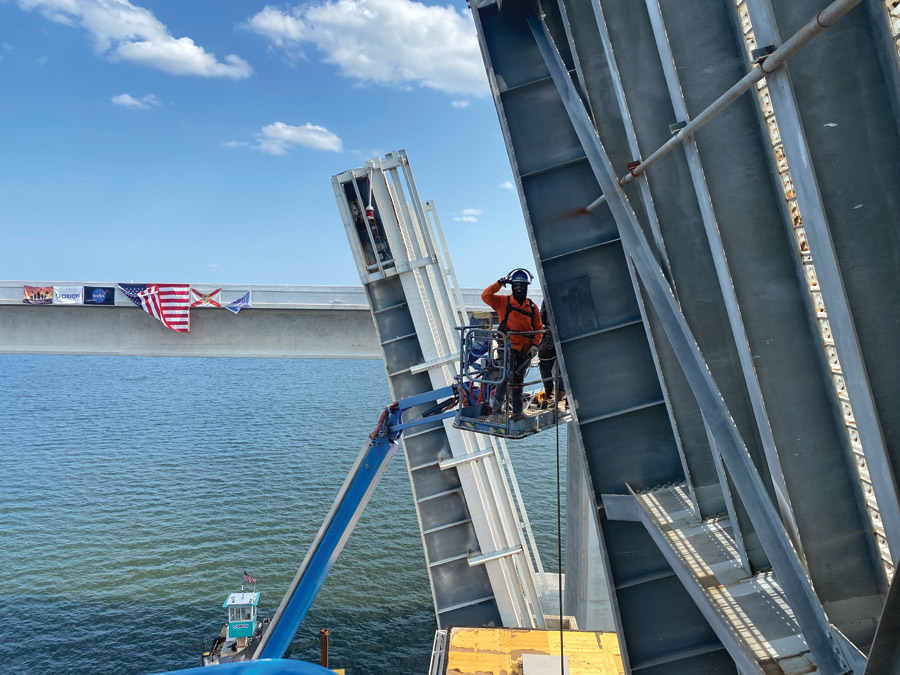
Removal of the existing bridges and demolition of the bascule foundations proved to be one of the project’s biggest challenges, says the contractor.
Photo courtesy Justin Ausanka, NASA
Both high-level fixed bridges are comprised of 78-in. and 96-in.-deep Florida-I beams supported on hammerhead piers with foundations consisting of 30-in. high-moment capacity square prestressed concrete pilings.
The new bridge has a lower than usual elevation rise of just 2%, which provides for easier movement of spacecraft flight hardware to KSC and the Cape Canaveral Space Force Station, according to the project team.
For Tyler Satterfield, project manager for Orion, the most challenging portion of the job has been removing and demolishing the four existing bascule foundations.
“On this job, you can’t just start driving piles,” he says. “You’ve got to get your demo ahead of your foundation. The most challenging part has been the bascule foundations ... where the leafs rise and fall right there. There’s a huge structure right there; the foundations go from water level probably 20 ft down.
“We have to drive coffer cells for sheets, demo the foundation down to the mud line, pull all the existing foundation pile and get everything clean,” he explains, adding that it’s taken roughly six weeks to remove and demolish each bascule foundation.
Bascule demolition—which involves workers being located in confined spaces and includes night work—required close coordination with NASA, says Justin Ausanka, technical integration manager with NASA and the space agency’s senior project manager for the bridge project.
“The different elements [of the work] in that environment at night required a lot of precoordination to make sure all the departmental stuff is taken care of,” Ausanka says. Also, because the Indian River is an Intracoastal waterway, the Coast Guard has oversight for the channel and can close it down to marine traffic if necessary.
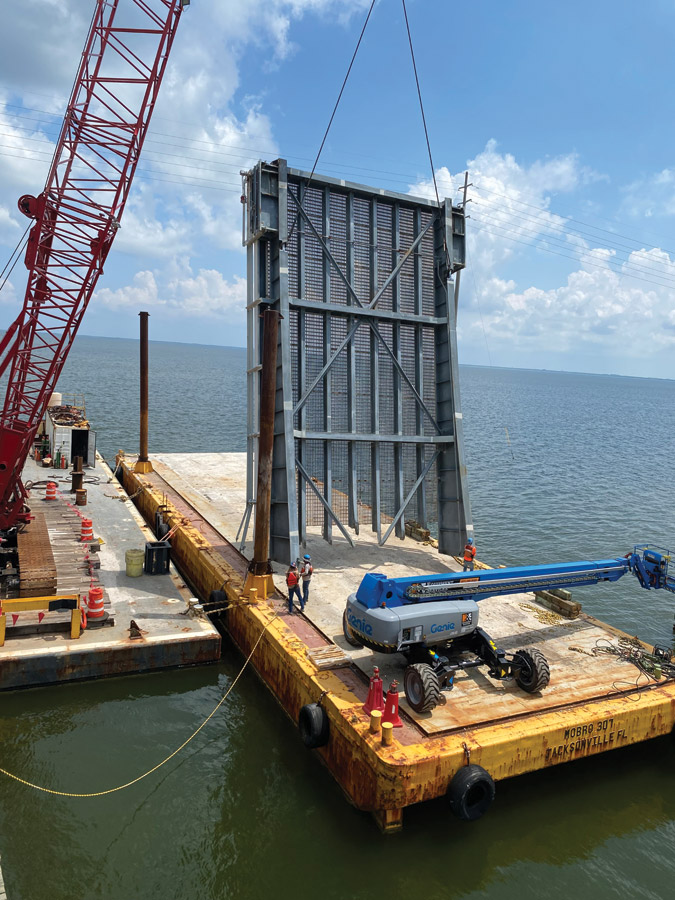
The construction team had to play close attention to environmental issues during the removal of the existing bridges.
“It’s just a lot of coordination,” he says.
The discovery of undocumented and unlabeled utilities was another issue at times, he adds.
“As [Orion] got into it, they’d say ‘Hey, what’s this conduit?’ So we had to stop and go get NASA people and do utility locates.”
Overall, achieving that first $3-million incentive payment involved much more work and effort than just the bascule foundations.
“Basically they were working six and seven days, with multiple shifts, with concrete pours at all hours of the night,” says Lynch. “It was just very, very fast paced.”
Construction work on the second span—with its $2-million incentive awaiting a March 2025 completion—is remaining similarly active, Lynch told ENR in late April.
“We’re driving pile, pouring foundations and caps, we’re pouring columns, setting beams and pouring deck,” he says. “All of that is ongoing as we speak because of that $2-million incentive bonus.”
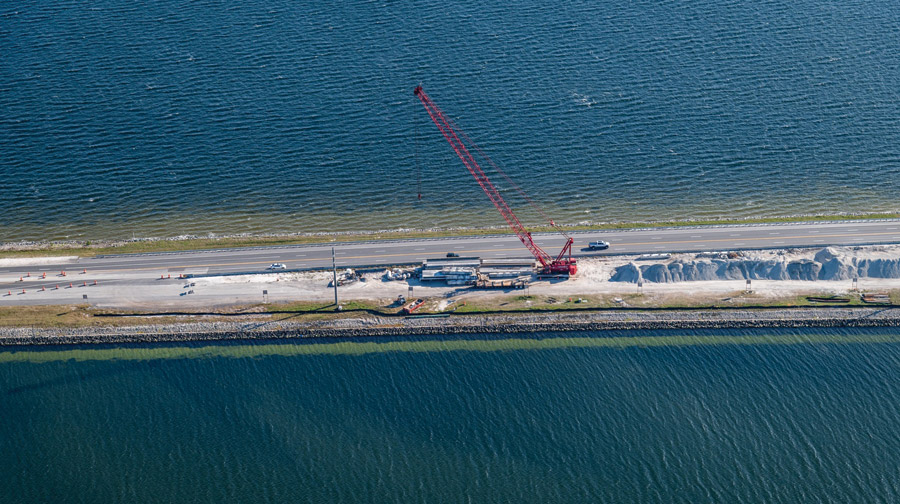
Work is continuing at a fast pace, heading for the March 2025 finish line.
Photo by Aerial Innovations, courtesy WSP
Coordinating with NASA
Orion’s ability to meet the first early-completion target is even more impressive considering some of the unexpected challenges the team faced from the start. As NASA’s Ausanka admits, “There are some challenges in working with the government.”
Additionally, NASA had its own set of logistical requirements, such as requiring all excavation work to halt within a certain window of time prior to, and sometimes after, its various launches.
Also, in this case, the project site—which is located in the midst of the Merritt Island National Wildlife Refuge, an overlay of NASA’s KSC—lacked power and internet service. On these issues, Ausanka was systemically prevented from helping out Orion.
“I can’t provide power for them; I can’t ask taxpayers to pay for the power that’s going to earn them money,” for instance, he says. “I could tell them ‘there’s power on that pole right there, but I can’t guarantee that you can use it.’ That turned out to be a major, major issue that nobody foresaw.”
“It was just a lot of logistics and integration challenges that nobody would have seen ahead of time.”
—Justin Ausanka, Technical Integration Manager, NASA
As a result, because power utility Florida Power & Light (FPL) didn’t own the property where Orion was setting up, “This [project site trailer] was running on generators for over a year because FPL couldn’t get a metered setup to them,” Ausanka says. Orion also had to use cellular WiFi for an extended period of time.
“It was just a lot of logistics and integration challenges that nobody would have seen ahead of time,” Ausanka says. “It was certainly a learning experience for us.”
Despite that early lingering challenge, Ausanka and Satterfield state that the coordination between NASA and the contractor team has been a major reason for the project’s progress to date.
Since the beginning of the project, Ausanka says, “Every time somebody brings up an issue, they also come with a solution, and we talk about it in real time, so it’s just worked out very well.”
NASA’s project manager also points out that despite the project’s non-urban location, there are a lot of “well-trained people that are looking to help contractors do things perfectly,” he says, referring to the space agency’s many engineers.
“Every one of the people over there [at KSC] is taught on their first day that if you see something that is unsafe, you have the power to go stop it,” Ausanka explains. “If you see something that’s environmentally damaging, you report it immediately.”
Despite the thousands of prying eyes, Orion and team have heard no complaints.
“I think it’s remarkable the [amount] of positive feedback that I’ve gotten from our folks on the NASA side,” he says. “I was preparing myself to have a thick skin and constantly be fielding complaints. But it’s been excellent. So, unless I see something, I’m gonna stay out of the way.”



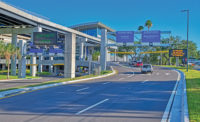
Post a comment to this article
Report Abusive Comment